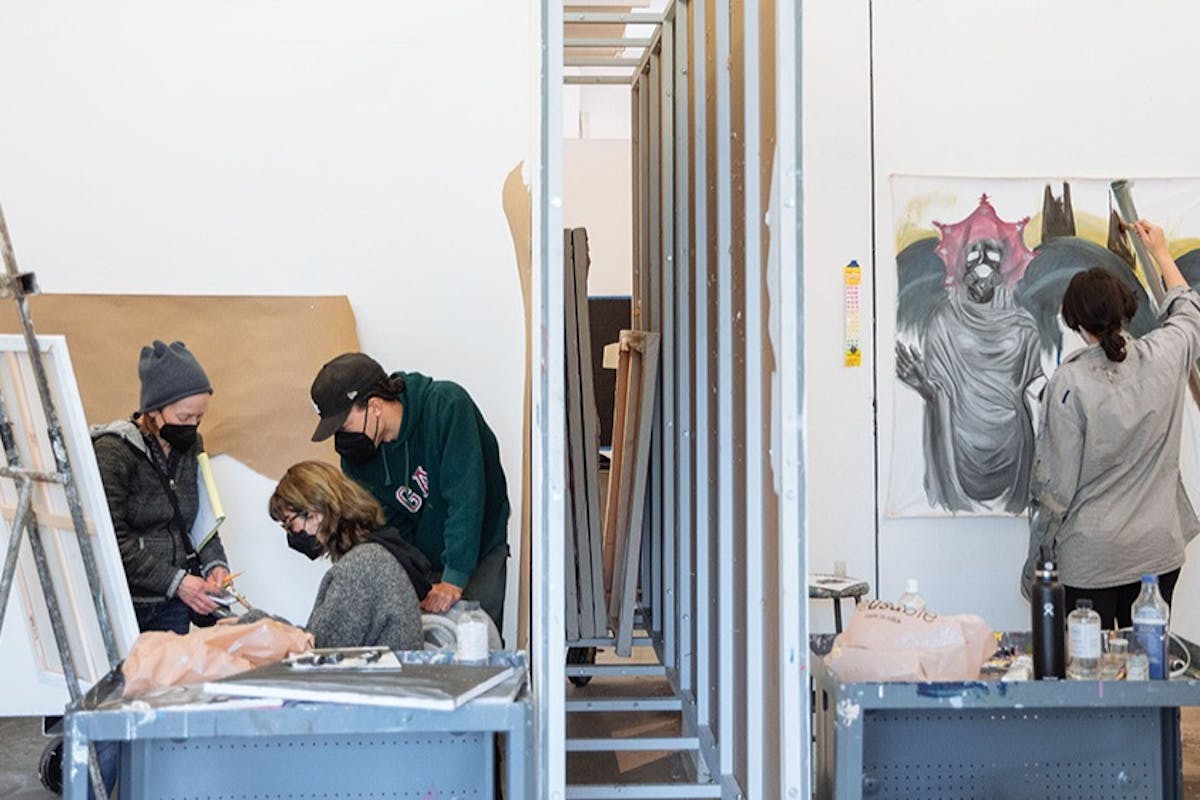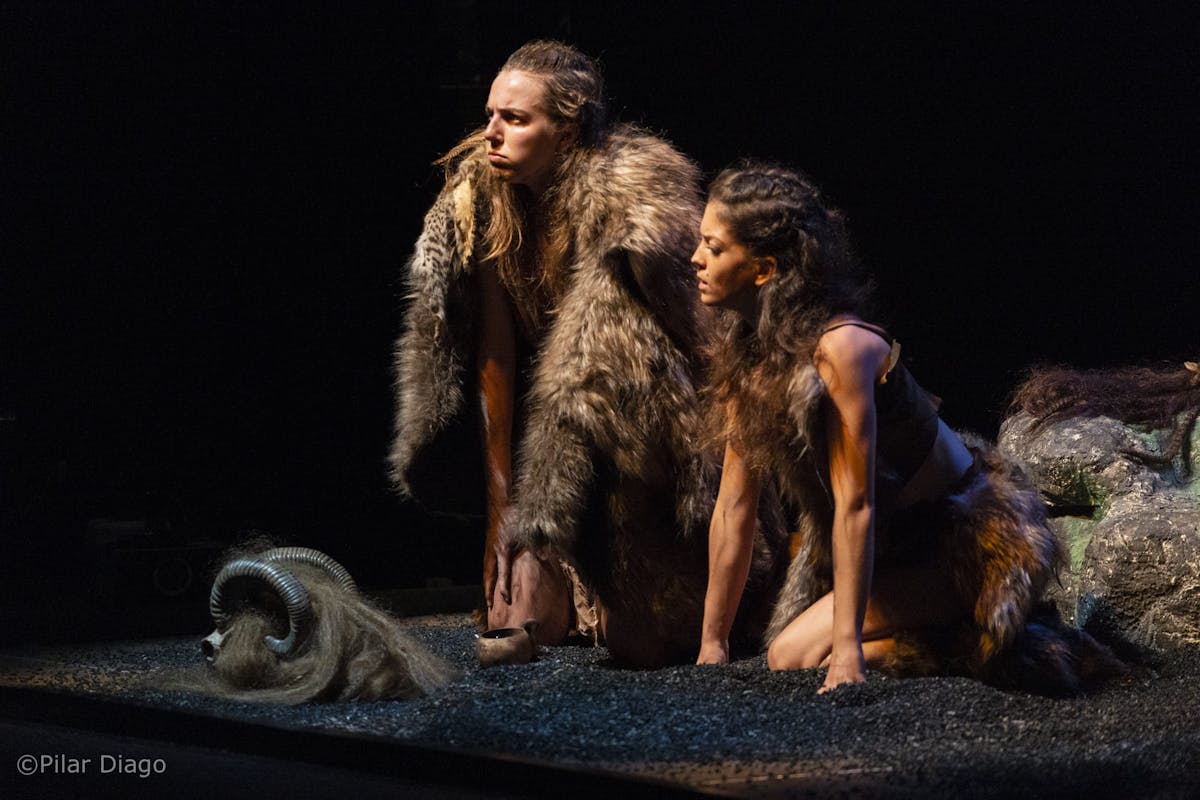AEDI in the classroom

Classes rooted in AEDI – anti-racism, equity, diversity, and inclusion – are being taught across the UCLA School of the Arts and Architecture. This winter quarter, two undergraduate Art studio classes – painting and new genres – are being taught as AEDI-themed courses.
We spoke to faculty members Patty Wickman and Vishal Jugdeo as well as students about this shift and how students are responding in the classroom.
Introducing Painting students to new voices
Wickman, a professor in the Department of Art since 1985, is teaching the course “Advanced Painting: Topics in Anti-Racism, Equity, Diversity, and Inclusion: Expanding and Critiquing Canon: Gender, Sexuality, and Race in Painting.” Wickman developed the idea for the class with fellow faculty members Rebecca Morris and Silke Otto-Knapp.
“Our feeling is actually that all of the classes in the department should have this focus. So, this was a way of getting us to each more intentionally bring it in as a central element to our teaching,” Wickman said.
As AEDI principles become folded into all studio classes, Wickman said, “there may not be a need for this specific designation.”
The class is structured in four segments: material, color, the body, and intersectional feminism. Students read and discuss critical essays by writers such as Audre Lorde and Kimberlé Crenshaw, while also examining works by artists such as Faith Ringgold, Kerry James Marshall, Jennifer Packer, and artists outside the Western art historical canon. Some also grapple with the themes in their paintings, though Wickman said there’s no strict rule that students incorporate the ideas of the readings in their own work.
Wickman said she was surprised to see students outside the department, and even outside the School of the Arts and Architecture, ask to take the class.
“I think there's a hunger for looking at these issues more deeply,” Wickman said.
Talia Markowitz, a fourth-year art major and Russian literature minor, said she was drawn to the combination of critical theory and art making.
“This is the first time I’ve concurrently read theory while in a studio. It's been interesting for me to think about readings other people in the class are thinking about, rather than just things I'm thinking about and reading on my own time,” Markowitz said.
Quinlan Lewis-Mussa, a fourth-year art major, says she’d never learned about improvisational Black American quilt making before this class. Learning about artists such as Rosie Lee Tompkins and Faith Ringgold is “going to be influencing my practice going forward,” she said.
Eva Speiser, a third-year cognitive science and art major, gave a presentation on artist Diedrick Brackens, known for his woven tapestries that explore Black and queer identity.
"There was an interview with him that was about depicting queer tenderness, and showing the Black and gay experience without showing the violence," she said. “The love and care that goes into the tapestries that he makes is just really nice to see.”
Ana Belcher, a third-year art major, is painting a series based on her own family’s photographs. Her portraits of Black family members are painted with a limited color palette of ultramarine, burnt sienna, and white against a black background.
"My practice is very much informed by conceptions of race and gender identity, so I felt like this class was perfect in terms of really trying to pinpoint what I'm trying to paint about," she said.
Belcher said that being in an AEDI-themed painting class has made it easier to discuss her own work in the context of race and gender.
“I feel like it's easier to have more open discussions about the content,” she said. “I feel more relaxed in terms of talking about my art and what I'm trying to convey, because you can relate it to the stuff that we're addressing in class."
New Genres looks beyond the canon
Vishal Jugdeo, who joined the Department of Art faculty in 2018, is teaching “Advanced New Genre: Topics in Anti-Racism, Equity, Diversity, and Inclusion: Anti-Oppression Methodologies in New Genres."
Jugdeo, an assistant professor and area head of new genres, describes new genres as an expansive term that includes film, sound, performance, installation, performance, and writing.
“I try to prioritize working with works that are experienced through time, just as a general way to frame things,” he said.
Prior to coming to UCLA, Jugdeo taught at California State University Long Beach, where he said his classes were mostly students of color. Teaching art with an AEDI focus has long been part of his teaching, he said.
“I think for a very long time as a teacher, the work that I've shown is less from the canon of art history, and more... prioritizing women artists, queer artists, artists of color, artists working with disability, and so that was already there in my teaching,” he said.
Early on in the class, Jugdeo introduced the idea of "critical fabulation,” an idea proposed by the writer and academic Saidiya Hartman, which includes “ways of looking through historical archives, particularly in the case where the archive is incomplete, so where it's subjects that have been, or histories that have been, left out of the archive or out of the official histories... how do we take these incomplete archives and imagine new possibilities out of them?”
The students also read an essay titled “Decolonizing Research Methodologies," which looks at research through the lens of Indigenous studies, posing the question: “what are ways that research can be anti-colonial, because research is actually thought of as a process that's deeply embedded within the process of colonization.”
Much like Wickman’s painting class, Jugdeo is not asking students to make work that comes directly out of the critical theory readings. Rather, his expectation is that their work comes out of their individual processes and interests, and “to maybe hold these frames of reference in the back of their mind as they work, but not necessarily artificially put it into the work."
Susan Aparicio, a graduate art student and the teaching assistant for the class, said the students in the class come from diverse backgrounds and feel more comfortable discussing their work in class.
"I think the students, when they're showing their work, they feel a lot more open to talk about their different backgrounds, traumas, and how to talk about that in an engaging way,” she said. “I've been in other classes where... they feel scared, or they're nervous, but in this class and the discussion, everyone is always like taking in all the work and telling them about theirself and about each other, and it’s always in an engaging discussion.”
Jugdeo says he chose the course title “anti-oppression methodologies” intentionally, because that framework of research and practice would attract students who are looking to create work in that vein.
“It became this beacon of light that we could work towards collectively as a group,” he said.
Armando Perez, a fourth-year art student who focuses on sculpture, said the class has made him think about how his work is presented accessibly.
“How do you pay attention to having exhibitions for someone that's blind or needs accessibility is in a special way? How do you create the same privileges for someone of different races that are marginalized or people that don't speak a language or whatever their vulnerabilities are in life?,” Perez said.
Jugdeo said that the department discussed whether to create AEDI-themed courses, and ultimately decided to do so as a way of moving towards incorporating a more diverse canon of artists into the curriculum.
"The goal is to actually translate all of our courses into AEDI courses, but this gives us a starting point,” he said. “We're figuring out what a new pedagogy for the 21st century should look like.”

